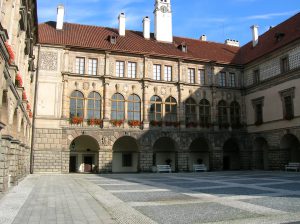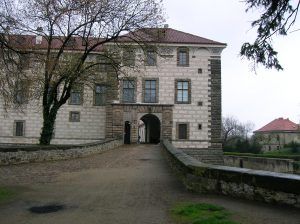Nelahozeves Chateau
By Tracy A. Burns
Nelahozeves Chateau near Prague

Only 35 kilometers from Prague, Nelahozeves Chateau is a superb choice for a day trip from Prague. Acclaimed for its captivating artwork, the Italian Renaissance structure features 12 rooms that portray the life of a noble family in the 19th century. Even the exterior of the chateau is stunning with its sgraffito-adorned wall depicting scenes from the Old Testament and floral motifs.
History of the chateau
It took more than 60 years to build the chateau, which was finally completed in 1614. The Lobkowiczs purchased the chateau in 1623. During the Thirty Years’ War Nelahozeves was occupied by Swedish forces, among others, and often came under attack. During the war that pitted the Austrians against the Prussians, the place was transformed into a military hospital. Later, it was used as a girls’ boarding school. The Lobkowicz family lost the chateau in World War II as it was confiscated by the Nazis. After the war the property was returned to them, only to be taken away again by the Communist regime. The Lobkowiczs were able to get the chateau back under restitution in 1993.
The Lobkowiczs in Czech history
 Many members of the Lobkowicz family have played significant roles in Czech history and politics. For example, Vaclav Eusebius served as an advisor to Holy Roman Emperors Ferdinand III and Leopold I. During World War II, Max Lobkowicz, the grandfather of the current owner, held the position of Czechoslovak ambassador to Great Britain, working for the government-in-exile in London.
Many members of the Lobkowicz family have played significant roles in Czech history and politics. For example, Vaclav Eusebius served as an advisor to Holy Roman Emperors Ferdinand III and Leopold I. During World War II, Max Lobkowicz, the grandfather of the current owner, held the position of Czechoslovak ambassador to Great Britain, working for the government-in-exile in London.
Artwork at Nelahozeves
The chateau’s paintings are certainly sights to behold. In addition to compelling 19th and 20th-century portraits of the Lobkowicz family, Nelahozeves shows off masterpieces by Peter Paul Rubens, Jan Brueghel the Elder, and Paolo Veronese, for instance. Pieter Brueghel the Younger created an idyllic winter scene of a village, too. Created by Sebastian Vrancx (1573 – 1647), three paintings feature cats dressed as members of the female aristocracy and monkeys representing the affluent men of society. In one painting monkeys are sword-fighting while another depicts the cats and monkeys celebrating at a banquet. The third portrays cats and monkeys taking a boat ride on the river. Cat lovers can buy postcards of the aristocratic cats and show them to their pets.
The interiors
However, there is more to Nelahozeves than paintings. Lots more. The library, though only a small portion of the books are on display, is made up of 65,000 volumes, including 679 manuscripts, 114 of which hail from the Middle Ages. There is a music archive on the premises, too. In the Drawing Room check out a gold Empire-style table, made with intarsia and flaunting gemstones. In the Reception Room a black cabinet, hailing from the 17th century, is adorned with biblical-related pictures as well as renditions of birds and flowers. The three-winged altar in the chapel is not to be missed, either. The Renaissance Knights’ Hall is stunning, decorated with paintings of knights on the walls and a 16th-century sandstone fireplace plus stucco reliefs on the ceiling, which is adorned with motifs from Roman history. Two rooms are decorated with furniture made from antlers.
Antonin Dvorak
Antonin Dvorak’s birthplace is very close to the chateau at number 12/277 below the castle, although it is open at odd hours. The museum focuses on the life and work of the composer, especially in his youth, when he lived there. It is definitely worth visiting and is a must for music lovers. Check opening times before you visit.
Why Nelahozeves?
How many chances do tourists have to see stunning artwork in an architectural gem of a chateau plus the birthplace of one of the greatest composers of all time during one day? The chapel, the Knights’ Hall, and the paintings are highlights of Nelahozeves Chateau, a place where tourists can take a break from hectic Prague and immerse themselves in the culture and lifestyle of the 19th-century nobility.




